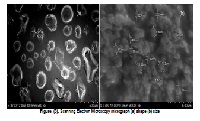Preparation, characterization and evaluation of finasteride ethosomes
Keywords:
Finasteride, ethosomes, Scanning electron microscopy, transdermal delivery, Zeta potentialAbstract
The present investigation attempted to prepare and evaluate the finasteride ethosomes for transdermal drug delivery. The ethosomal formulations were developed using different concentrations of ethanol (20-60%) and soya lecithin (1-5%). In-vitro release studies of formulation containing 30% ethanol and 3% soya lecithin showed highest % drug release (82.66%) with highest transdermal flux. The entrapment efficiency and drug content of optimized formulation were found to be 85.32% and 99.5% respectively. Scanning Electron micrographs revealed that the formed vesicles were spherical in shape with uniform size. It was also observed that concentration of the ethanol had profound influence on entrapment efficiency. The drug release from the formed vesicles was found to follow first order kinetics with higuchi diffusion mechanism. The transdermal delivery of finasteride could be potentially enhanced when they were formulated into ethosomes. This ethosomal drug delivery was found to be promising than could be a nanogel.
References
. Gangwar S, Singh S, Garg G. Ethosomes: A novel tool for drug delivery through the skin. J Pharm Res. 2010; 3(4): 688–691.
. Ahad A, Aqil M, Kohli K, Chaudhary H, Sultana Y, Mujeeb M, Talegaonka S. Chemical penetration enhancers: A patent review. Expert Opin Ther Pat. 2009; 19: 969–988.
. Ahad A, Al-Jenoobi FI, Al-Mohizea AM, Aqil M, Kohli K. Transdermal delivery of calcium channel blockers for hypertension. Expert Opin Drug Deliv. 2013: 10: 1137–1153.
. Schreier H, Bouwstra JA. Liposomes and niosomes as topical drug carriers: Dermal and Transdermal drug delivery. J Controlled Release. 1994; 30: 1–15.
. Ahad A, Aqil M, Kohli K, Sultana Y, Mujeeb M, Ali A. Formulation and optimization of nanotransfersomes using experimental design technique for accentuated transdermal delivery of valsartan. Nanomedicine. 2012; 8: 237–249.
. Ahad A, Aqil M, Kohli K, Sultana Y, Mujeeb M. Enhanced transdermal delivery of an antihypertensive agent via nanoethosomes: statistical optimization, characterization and pharmacokinetic assessment. Int J Pharm. 2013; 443: 26–38.
. Touitou E, Dayan N, Levi-Schaffer F, Piliponsky A. Novel lipid vesicular system for enhanced delivery. J Lip Res. 1998; 8: 113–114.
. Barry B.W. Novel mechanisms and devices to enable successful transdermal drug Delivery. Eur J Pharm Sci. 2001; 14: 101–114.
. Touitou E, Dayan N, Bergelson L, Godin B, Eliaz M. Ethosomes novel vesicular carriers for enhanced delivery: characterization and skin penetration properties. J Cont Release. 2000; 65: 403–418.
. Elsayed MA, Abdallah YO, Naggar FV, Khalafallah NM. Deformable ethosomes and liposomes: Mechanism of enhanced skin delivery. Int J Pharm. 2006; 322: 60–66.
. Touitou E, Dayan N, Bergelson L, Godin B, Eliaz M. Ethosomes-novel vesicular carriers for enhanced delivery: Characterization and skin penetration properties. J Controlled Release. 1999; 65: 403–18.
. Touitou E, Godin B, Dayan N, Weiss C, Piliponsky A, Levi-Schaffer F. Intracellular delivery mediated by an ethosomal carrier. Biomaterials. 2001; 22: 3053–3059.
. Dubey V, Mishra D, Dutta T, Nahar M, Saraf DK, Jain NK. Dermal and transdermal delivery of an anti-psoriatic agent via ethanolic liposomes. J Controlled Release. 2007; 123: 148–154.
. Span PN, Voller MC, Smals AG, Sweep FG, Schalken JA, Feneley MR, Kirby RS. Selectivity of finasteride as an in vivo inhibitor of 5 alpha-reductase isozyme enzymatic activity in the human prostate. J Urol. 1999; 161: 332–337.
. Berge V, Swartzendruber VB, Geest J. Development of an optimal protocol for the ultra structural examination of skin by transmission electron microscopy. J Microscopy. 1997; 187(2): 125–133.
. Maghraby GM, Williams AC, Barry BW. Oestradiol skin delivery from ultra formable liposomes: refinement of surfactant concentration. Int J Pharm. 2000; 196: 63–74.
. Cevc G, Schatzlein A, Blume G. Transdermal drug carriers: Basic properties, optimization & transfer efficiency in case of epicutaneously applied peptides. J Controlled Release. 1995; 36: 3–16.
. Lopez-Pinto JM, Gonzalez-Rodriguez ML, Rabasco AM. Effect of cholesterol and ethanol on dermal delivery from DPPC liposomes. Int J Pharm. 2005; 298: 1–12.
. Toll R, Jacobi U, Richter H, Lademann J, Schaefer H, Blume U. Penetration profile of microspheres in follicular targeting of terminal hair follicles. J Invest Dermatol. 2004; 123: 168–176.
. Donatella P, Christian C, Elena T, Felisa C, Massimo F. Paclitaxel-loaded ethosomes: Potential treatment of squamous cell carcinoma, a malignant transformation of actinic keratoses. Eur J Pharm Biopharm. 2012; 81: 102–112.
. Ying ZZ, Cui TL, Yi Z, Jian X, Ya PZ, Yan YX, Zhi GF, Chong YX, Ji LT. Selection of high efficient transdermal lipid vesicle for curcumin Skin delivery. Int J Pharm. 2013; 454: 302–309.
. Sujitha B, Krishnamoorthy B, Muthukumaran M. Formulation and Evaluation of Piroxicam Loaded Ethosomal Gel for Transdermal Delivery. Int J Adv Pharm Gen Res. 2014; 2(1):34–45.
. Li NS, Yong TZ, Qin W, Ling X, Nian PF. Enhanced in vitro and in vivo skin deposition of apigenin delivered using ethosomes. Int J Pharm. 2014; 460: 280–288.
. Ketul KP, Praveen K, Hetal PT. Formulation of Niosomal Gel for Enhanced Transdermal Lopinavir Delivery and Its Comparative Evaluation with Ethosomal Gel, AAPS Pharm Sci Tech. 2012; 13(4): 1502–1510.






